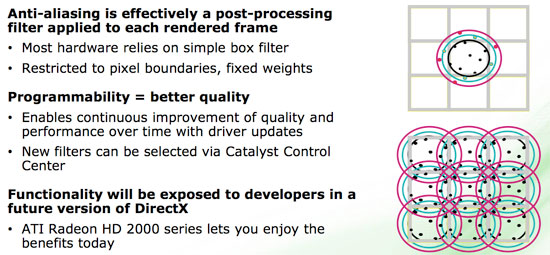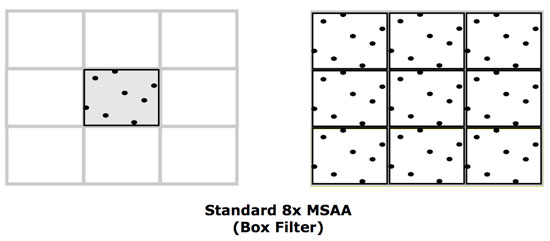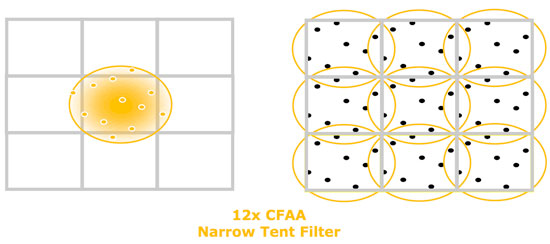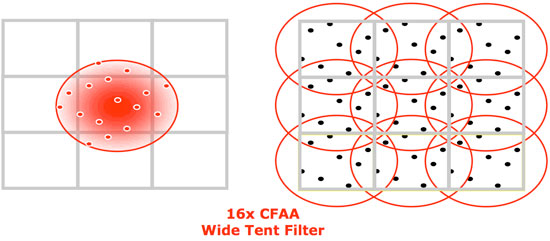ATI Radeon HD 2900 XT: Calling a Spade a Spade
by Derek Wilson on May 14, 2007 12:04 PM EST- Posted in
- GPUs
CFAA and No Fixed Resolve Hardware
That's right, R600 doesn't have hardware dedicated to resolving MSAA in the render back end - the only MSAA related tasks handled in the render back end are compression and evaluation of the subpixels. All antialiasing resolve is performed on the shader hardware. Certainly, AMD would prefer we start by telling you about the neat custom resolve filters that can be implemented on their shader hardware, but we would rather speculate about this for a moment first.
AMD has stated that, moving forward, in addition to allowing programmable sample patterns, future DX versions may allow for custom resolve filters as well. This is cited as one of the reasons why R600 uses shader hardware to resolve AA samples. AMD has given us a couple different resolve filters to play with, which we'll talk about in a minute. But at a point where we're seeing the first DX10 hardware from graphics makers, and at a time where competitive performance is paramount, it doesn't seem like the decision we would have made.
Whatever the circumstances, R600 sends its pixels back up from the render back ends to the shader hardware to combine subpixel data into a final pixel color. In addition to the traditional "box" filter (which uses subpixels within the area of a single pixel), the new driver offers the ability to use subpixel data from neighboring pixels resolved with a tent filter (where the impact of the subpixels on final color is weighted by distance). AMD calls this CFAA for custom filter antialiasing.

AMD currently offers narrow and wide tent filters which can be implemented using 2, 4, or 8 multisamples per pixel boundary. This gives us nine different AA options including traditional box filters. More filter options can be provided via driver updates, as these are essentially driver managed shader programs. Here's the breakdown of the options based on the type of filter and the number of samples used to resolve each pixel.



One of the useful side effects of these tent filters is that they are also capable of antialiasing interior pixels, not just those covered by more than one triangle. This is helpful in getting rid of aliasing in textures which can occur in certain cases.
While tent filters are a very interesting idea to improve antialiasing, they are not without their drawbacks. First, it is possible for tent filters, even though neighboring subpixel data is weighted less than internal subpixels, to create a muddy look, especially with high contrast fine detail like thin text for example. While tent filters can antialias textures on interior pixels, they can also create a blur effect where it isn't needed which removes detail from the scene.
Edge Detection
While tent filters are good in the general edge case, in order to be really compelling from an image quality stand point, AMD decided to go a step further and adaptively apply more AA in places where it would do the most good and less elsewhere. This will be done by applying an edge detect algorithm to the framebuffer and using more aggressive AA on these edges.
We learned that edge detection can be sped up by looking at pixel compression. If all the subpixels for one fragment are the same color, compression will be at its highest and there is no edge within that pixel. Beyond using this information, we are told that the algorithm uses straightforward derivative computations to find high frequency data (high contrast edges) much the same way Photoshop does.
The combination of edge detection and tent filters gives us two extra option beyond the ones listed above: 12x narrow tent filter with edge detect and 24x wide tent filter with edge detect. These filters are capable of very good image quality, though this quality does come at a performance cost. We will take a look at performance and image quality after we finish going through R600 hardware.










86 Comments
View All Comments
wjmbsd - Monday, July 2, 2007 - link
What is the latest on the so-called Dragonhead 2 project (aka, HD 2900 XTX)? I heard it was just for OEMs at first...anyone know if the project is still going and how the part is benchmarking with newest drivers?teainthesahara - Monday, May 21, 2007 - link
After this failure of the R600 and likely overrated(and probably late) Barcelona/Agena processors I think that Intel will finally bury AMD. Paul Ottelini is rubbing his hands with glee at the moment and rightfully so. AMD now stands for mediocrity.Oh dear what a fall from grace.... To be honest Nvidia don't have any real competition on the DX10 front at any price points.I cannot see AMD processors besting Intel's Core 2 Quad lineup in the future especially when 45nm and 32 nm become the norm and they don't have a chance in hell of beating Nvidia. Intel and Nvidia are turning the screws on Hector Ruiz.Shame AMD brought down such a great company like ATI.DerekWilson - Thursday, May 24, 2007 - link
To be fair, we really don't have any clue how these cards compete on the DX10 front as there are no final, real DX10 games on the market to test.We will try really hard to get a good idea of what DX10 will look like on the HD 2000 series and the GeForce 8 Series using game demos, pre-release code, and SDK samples. It won't be a real reflection of what users will experience, but we will certainly hope to get a glimpse at performance.
It is fair to say that NVIDIA bests AMD in current game performance. But really there are so many possibilities with DX10 that we can't call it yet.
spinportal - Friday, May 18, 2007 - link
From the last posting of results for the GTS 320MB round-uphttp://www.anandtech.com/video/showdoc.aspx?i=2953...">Prey @ AnandTech - 8800GTS320
we see that the 2900XT review chart pushes the nVidia cards down about 15% across the board.
http://www.anandtech.com/video/showdoc.aspx?i=2988...">Prey @ AnandTech - ATI2900XT
The only difference in systems is software drivers as the cpu / mobo / mem are the same.
Does this mean ATI should be getting a BIGGER THRASHING BEAT-DOWN than the reviewer is stating?
400$ ATI 2900XT performing as good as a 300$ nVidia 8800 GTS 320MB?
Its 100$ short and 6 months late along with 100W of extra fuel.
This is not your uncle's 9700 Pro...
DerekWilson - Sunday, May 20, 2007 - link
We switched Prey demos -- I updated our benchmark.Both numbers are accurate for the tests I ran at the time.
Our current timedemo is more stressful and thus we see lower scores with this test.
Yawgm0th - Wednesday, May 16, 2007 - link
The prices listed in this article are way off.Currently, 8800GTS 640MB retails for $350-380, $400+ for OC or special versions. 2900XT retails for $430+. In the article, both are listed as $400, and as such the card is given a decent review in the conclusion.
Realistically, this card provides slightly inferior performance to the 8800GTS 640MB at a considerably higher price point -- $80-$100 more than the 8800GTS. I mean, it's not like the 8800Ultra, but for the most part this card has little use outside of AMD and/or ATI fanboys. I'd love for this card to do better as AMD needs to be competing with Nvidia and Intel right now, but I just can't see how this is even worth looking at, given current prices.
DerekWilson - Thursday, May 17, 2007 - link
really, this article focuses on architechture more than product, and we went with MSRP prices...we will absolutly look closer at price and price/performance when we review retail products.
quanta - Tuesday, May 15, 2007 - link
As I recalled, the Radeon HD 2900 only has DVI ports, but nowhere in DVI documentation specifies it can carry audio signals. Unless the card comes with adapter that accepts audio input, it seems the audio portion of R600 is rendered useless.DerekWilson - Wednesday, May 16, 2007 - link
the card does come with an adapter of sorts, but the audio input is from the dvi port.you can't use a standard DVI to HDMI converter for this task.
when using AMD's HDMI converter the data sent out over the DVI port does not follow the DVI specification.
the bottom line is that the DVI port is just a physical connector carrying data. i could take a DVI port and solder it to a stereo and use it to carry 5.1 audio if I wanted to ... wouldn't be very useful, but I could do it :-)
While connected to a DVI device, the card operates the port according to the DVI specification. When connected to an HDMI device through the special converter (which is not technically "dvi to hdmi" -- it's amd proprietry to hdmi), the card sends out data that follows the HDMI spec.
you can look at it another way -- when the HDMI converter is connected, just think of the dvi port as an internal connector between an I/O port and the TMDS + audio device.
ShaunO - Tuesday, May 15, 2007 - link
I was at an AMD movie night last night where they discussed the technical details of the HD 2900 XT and also showed the Ruby Whiteout DX10 Demo rendered using the card. It looked amazing and I had high hopes until I checked out the benchmark scores. They're going to need more than free food and popcorn to convince me to buy an obsolete card.However there is room for improvement of course. Driver updates, DX10 and whatnot. The main thing for me personally will be driver updates, I will be interested to see how well the card improves over time while I save my pennies for my next new machine.
Everyone keeps saying "DX10 performance will be better, yadda yadda" but I also want to be able to play the games I have now and older games without having to rely on DX10 games to give me better performance. Nothing like totally underperforming in DX9 games and then only being equal or slightly better in DX10 games compared to the competition. I would rather have a decent performer all-round. Even saying that we don't even know for sure if DX10 games are even going to bring any performance increases of the competition, it's all speculation right now and that's all we can do, speculate.
Shaun.